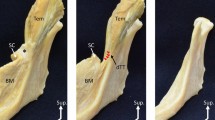Abstract
Abstract: The authors carried out an anatomical and magnetic resonance imaging study on the architecture of the mandibular elevator muscles of 169 cadavers. The aim of the study was to define the organisational architecture of the human masseter, temporal and pterygoid muscles. Layer by layer dissection and anatomical cuts in different spatial planes showed that the temporal muscle has a different architecture to the other mandibular elevator muscles. Indeed this muscle does not have the pennate structure of the masseter and pterygoid muscles. Through electromyographic study the behavior of this muscle allowed the establishment of its functional segmentation during the masticatory cycle. Our study showed three distinct anatomical portions in the middle of the temporal muscle which correspond to this functional classification. The MRI study confirmed the results of our anatomical study.
Similar content being viewed by others
Author information
Authors and Affiliations
Corresponding author
Rights and permissions
About this article
Cite this article
Gaudy, JF., Zouaoui, A., Bri, P. et al. Functional anatomy of the human temporal muscle. Surg Radiol Anat 23, 389–398 (2002). https://doi.org/10.1007/s00276-001-0389-z
Received:
Accepted:
Issue Date:
DOI: https://doi.org/10.1007/s00276-001-0389-z




